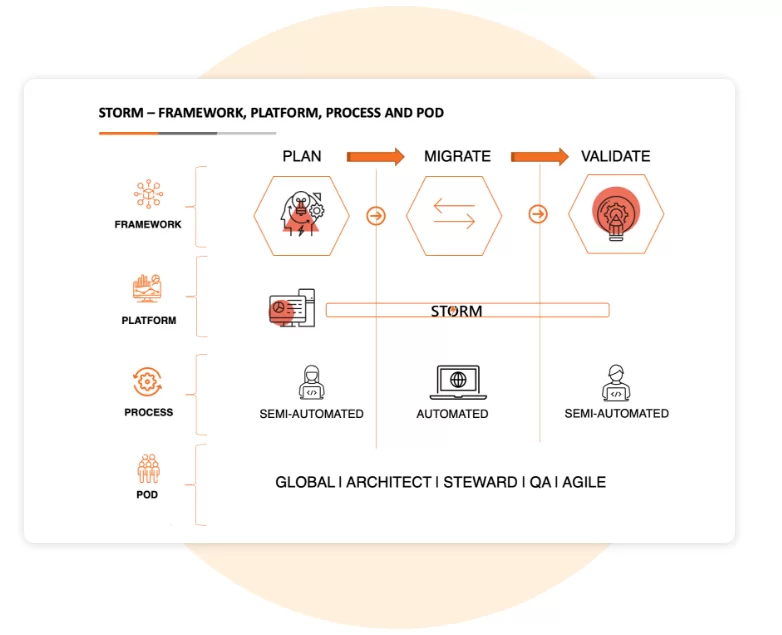Beyond Lift and Shift: Strategies for Successful Cloud Migration
Modernizing Your Migration Strategy: Going Beyond “Lift and Shift”
The Next Steps After Lift and Shift: Ensuring Success in Cloud Migration
USEReady has helped many enterprise clients migrate legacy data and analytics platforms to modern environments and tech stacks since our partnership with Tableau in the year 2012. We have had a great track record of successes and can share many client stories where significant business outcomes were achieved. The common thread that runs through these success stories is that the migrations were transformational in nature – our clients were not satisfied with just a ‘lift and shift’.
The term ‘lift and shift’ implies that you move data or reports from one environment to another, without making improvements other than the change of location. Consolidating, rethinking, validating, modernizing, and optimizing are all verbs, among others, that are critical in the move to a more transformative end state. It is probable that there will be phases of execution that led to incremental achievements in the transformation program, but the plan and activity should all be driving towards a transformational end state. Anything else is a sub-optimization of the migration investment.

However, there are always exceptions. Sometimes, for the short term, there can be a need to get a migration completed, stripped of most, if not all, of the transformational verbs above. The critical term here is “short term” – once the migration is done, we need to move into the transformational stage of the program. The migration should not be the end game.
Why Lift and Shift Isn’t Enough: The Limitations of Simple Migration Strategies
Modernization Strategies: Enhancing Your Cloud Migration for Long-Term Success
Optimizing Your Cloud Environment: Key Considerations for Post-Migration Efficiency
The Importance of Ongoing Management: Maintaining Performance and Security in the Cloud
Moving Beyond Basic Migration: Understanding the Full Potential of Cloud Adoption
Strategies for Cloud Modernization: Transforming Your Infrastructure for the Future
Key Considerations for Optimizing Your Cloud Resources: Lessons Learned from Successful Migrations
Ensuring Long-Term Success: Best Practices for Managing Your Cloud Environment Post-Migration
For many Tableau Environment owners, that exact situation has arrived. It is time to migrate from Tableau on premise to Tableau Cloud.
What is going on and why is this the case?
- Increase Agility and Scalability – Leverage cloud elasticity to support workloads across your organization and scale growth. Engage every employee with a mobile-friendly, modern cloud-first analytics solution. Easily accomplish adaptability, security, and control to push your business ahead.
- Drive Innovation – Help your BI team’s productivity by limiting operational overhead and freeing up resources to innovate. Reduce vulnerability by always operating on the latest version of Tableau and enjoying guaranteed availability. Operate confidently without worrying about updates, upgrades, or end of support again.
- Accelerate Returns on Analytics Investments – You should expect to Accelerate Return on Investment (ROI) for your complex analytics needs. Ramp up thousands of users quickly. Achieve improved security and increased reliability by outsourcing your infrastructure management and administrative tasks.
Please refer here: https://www.tableau.com/why-tableau/tableau-migration
USEReady acknowledges the urgency around the situation and has developed a path forward to get it done. We have developed an automation tool to make the migration from Tableau on premise to Tableau Cloud not only possible, but also with greater velocity and less pain to the organization. We call this path forward and the tool that serves as the accelerator, “STORM”.
Our point of view is that this is a situation that calls for a first phase of effort that is in most circumstances best achieved via the maligned ‘lift and shift’ approach. We view that getting the migration done with expediency makes the most sense for most client situations. However, relative to the guidance presented above, we also recommend that, upon completion of the migration, follow-on phases should focus on a more transformational end game, such as report optimization and consolidation.

STORM is an automation tool as part of the Plan → Migrate → Validate framework to move Dashboards from Tableau Server to Tableau Cloud. It allows you to Plan, Migrate and Validate your move from on-prem to cloud while automating steps in the framework for a fast, consistent, and seamless process.
The move to Tableau Cloud, as a more modern analytics environment, presents an opportunity to take your BI Program to another level of maturity, which also warrants transformational planning to maximize business outcomes.
If you are a Tableau on premise owner and are considering a migration or want more information about the benefits of migration, we can help to answer questions. It should be stated that migration automation is not for everyone. For those with only a handful of users, it will likely make the most sense to move forward with a manual approach. For larger organizations, if you were hoping to go manual, all I can say is that hope is a weak strategy. We have also authored a book to share with you our learnings on Tableau Migration. It has detailed inputs on the Plan → Migrate → Validate framework which will be helpful in successful Tableau migrations for your organization.
If you would like to learn more about STORM click here.
We sincerely look forward to hearing from you.


